2017 CHEVROLET EXPRESS CARGO VAN child restraint
[x] Cancel search: child restraintPage 41 of 346
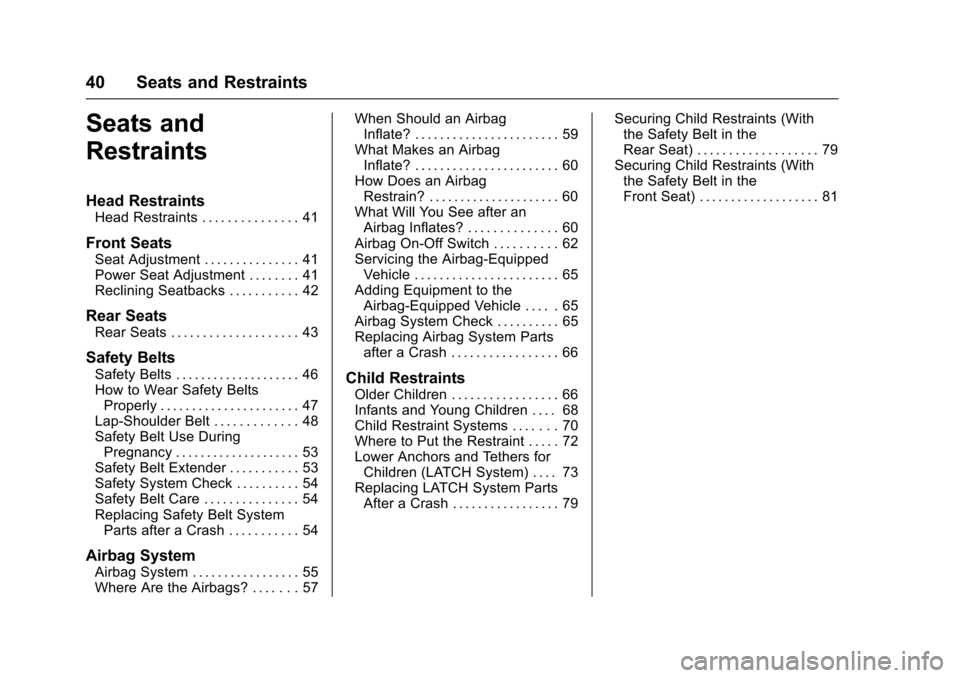
Chevrolet Express Owner Manual (GMNA-Localizing-U.S./Canada/Mexico-9967827) - 2017 - crc - 5/2/16
40 Seats and Restraints
Seats and
Restraints
Head Restraints
Head Restraints . . . . . . . . . . . . . . . 41
Front Seats
Seat Adjustment . . . . . . . . . . . . . . . 41Power Seat Adjustment . . . . . . . . 41Reclining Seatbacks . . . . . . . . . . . 42
Rear Seats
Rear Seats . . . . . . . . . . . . . . . . . . . . 43
Safety Belts
Safety Belts . . . . . . . . . . . . . . . . . . . . 46How to Wear Safety BeltsProperly . . . . . . . . . . . . . . . . . . . . . . 47Lap-Shoulder Belt . . . . . . . . . . . . . 48Safety Belt Use DuringPregnancy . . . . . . . . . . . . . . . . . . . . 53Safety Belt Extender . . . . . . . . . . . 53Safety System Check . . . . . . . . . . 54Safety Belt Care . . . . . . . . . . . . . . . 54Replacing Safety Belt SystemParts after a Crash . . . . . . . . . . . 54
Airbag System
Airbag System . . . . . . . . . . . . . . . . . 55Where Are the Airbags? . . . . . . . 57
When Should an AirbagInflate? . . . . . . . . . . . . . . . . . . . . . . . 59What Makes an AirbagInflate? . . . . . . . . . . . . . . . . . . . . . . . 60How Does an AirbagRestrain? . . . . . . . . . . . . . . . . . . . . . 60What Will You See after anAirbag Inflates? . . . . . . . . . . . . . . 60Airbag On-Off Switch . . . . . . . . . . 62Servicing the Airbag-EquippedVehicle . . . . . . . . . . . . . . . . . . . . . . . 65Adding Equipment to theAirbag-Equipped Vehicle . . . . . 65Airbag System Check . . . . . . . . . . 65Replacing Airbag System Partsafter a Crash . . . . . . . . . . . . . . . . . 66
Child Restraints
Older Children . . . . . . . . . . . . . . . . . 66Infants and Young Children . . . . 68Child Restraint Systems . . . . . . . 70Where to Put the Restraint . . . . . 72Lower Anchors and Tethers forChildren (LATCH System) . . . . 73Replacing LATCH System PartsAfter a Crash . . . . . . . . . . . . . . . . . 79
Securing Child Restraints (Withthe Safety Belt in theRear Seat) . . . . . . . . . . . . . . . . . . . 79Securing Child Restraints (Withthe Safety Belt in theFront Seat) . . . . . . . . . . . . . . . . . . . 81
Page 48 of 346
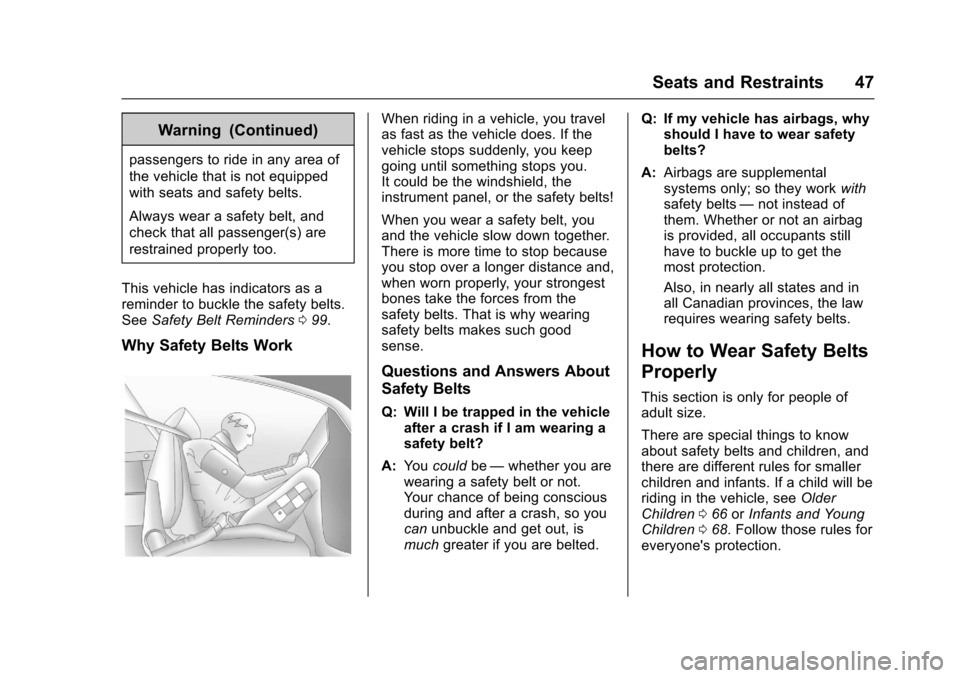
Chevrolet Express Owner Manual (GMNA-Localizing-U.S./Canada/Mexico-9967827) - 2017 - crc - 5/2/16
Seats and Restraints 47
Warning (Continued)
passengers to ride in any area of
the vehicle that is not equipped
with seats and safety belts.
Always wear a safety belt, and
check that all passenger(s) are
restrained properly too.
This vehicle has indicators as areminder to buckle the safety belts.SeeSafety Belt Reminders099.
Why Safety Belts Work
When riding in a vehicle, you travelas fast as the vehicle does. If thevehicle stops suddenly, you keepgoing until something stops you.It could be the windshield, theinstrument panel, or the safety belts!
When you wear a safety belt, youand the vehicle slow down together.There is more time to stop becauseyou stop over a longer distance and,when worn properly, your strongestbones take the forces from thesafety belts. That is why wearingsafety belts makes such goodsense.
Questions and Answers About
Safety Belts
Q: Will I be trapped in the vehicleafter a crash if I am wearing asafety belt?
A:Yo ucouldbe—whether you arewearing a safety belt or not.Yo u r c h a n c e o f b e i n g c o n s c i o u sduring and after a crash, so youcanunbuckle and get out, ismuchgreater if you are belted.
Q: If my vehicle has airbags, whyshould I have to wear safetybelts?
A:Airbags are supplementalsystems only; so they workwithsafety belts—not instead ofthem. Whether or not an airbagis provided, all occupants stillhave to buckle up to get themost protection.
Also, in nearly all states and inall Canadian provinces, the lawrequires wearing safety belts.
How to Wear Safety Belts
Properly
This section is only for people ofadult size.
There are special things to knowabout safety belts and children, andthere are different rules for smallerchildren and infants. If a child will beriding in the vehicle, seeOlderChildren066orInfants and YoungChildren068.Followthoserulesforeveryone's protection.
Page 50 of 346
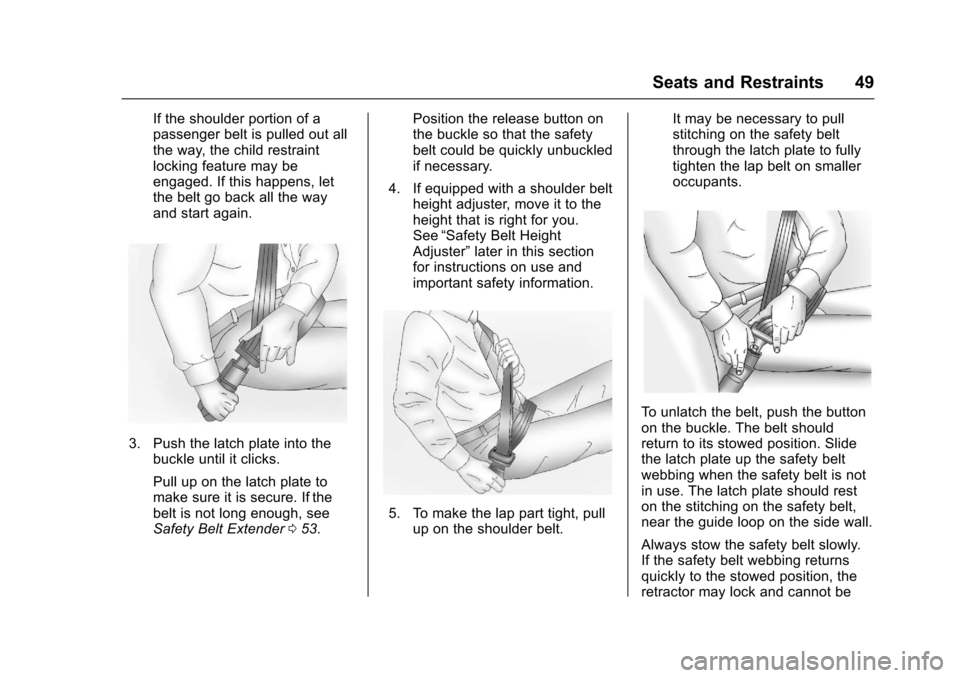
Chevrolet Express Owner Manual (GMNA-Localizing-U.S./Canada/Mexico-9967827) - 2017 - crc - 5/2/16
Seats and Restraints 49
If the shoulder portion of apassenger belt is pulled out allthe way, the child restraintlocking feature may beengaged. If this happens, letthe belt go back all the wayand start again.
3. Push the latch plate into thebuckle until it clicks.
Pull up on the latch plate tomake sure it is secure. If thebelt is not long enough, seeSafety Belt Extender053.
Position the release button onthe buckle so that the safetybelt could be quickly unbuckledif necessary.
4. If equipped with a shoulder beltheight adjuster, move it to theheight that is right for you.See“Safety Belt HeightAdjuster”later in this sectionfor instructions on use andimportant safety information.
5. To make the lap part tight, pullup on the shoulder belt.
It may be necessary to pullstitching on the safety beltthrough the latch plate to fullytighten the lap belt on smalleroccupants.
To u n l a t c h t h e b e l t , p u s h t h e b u t t o non the buckle. The belt shouldreturn to its stowed position. Slidethe latch plate up the safety beltwebbing when the safety belt is notin use. The latch plate should reston the stitching on the safety belt,near the guide loop on the side wall.
Always stow the safety belt slowly.If the safety belt webbing returnsquickly to the stowed position, theretractor may lock and cannot be
Page 52 of 346
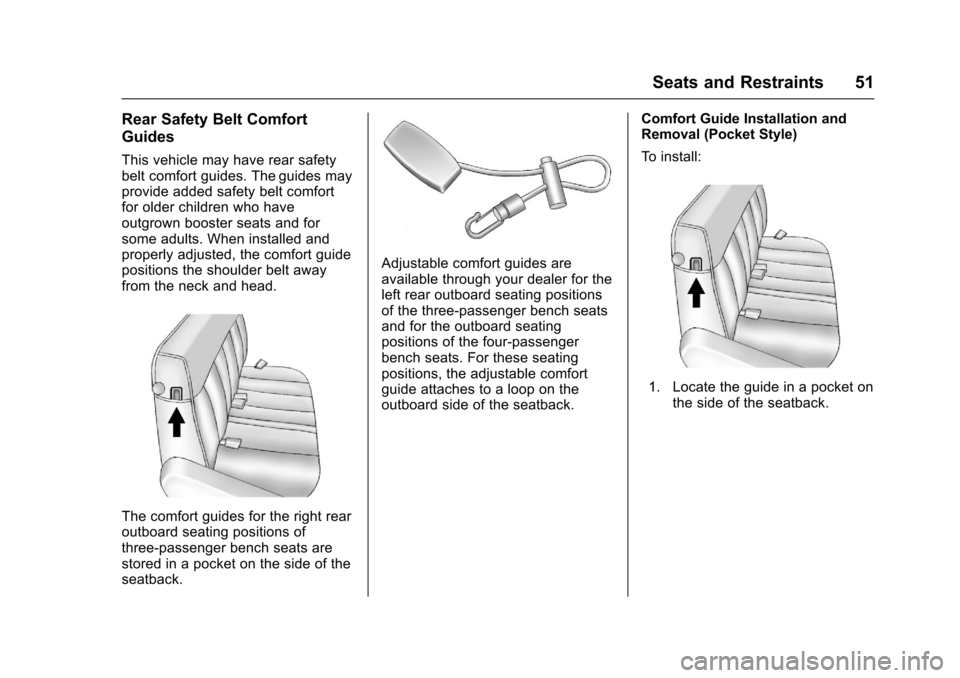
Chevrolet Express Owner Manual (GMNA-Localizing-U.S./Canada/Mexico-9967827) - 2017 - crc - 5/2/16
Seats and Restraints 51
Rear Safety Belt Comfort
Guides
This vehicle may have rear safetybelt comfort guides. The guides mayprovide added safety belt comfortfor older children who haveoutgrown booster seats and forsome adults. When installed andproperly adjusted, the comfort guidepositions the shoulder belt awayfrom the neck and head.
The comfort guides for the right rearoutboard seating positions ofthree-passenger bench seats arestored in a pocket on the side of theseatback.
Adjustable comfort guides areavailable through your dealer for theleft rear outboard seating positionsof the three-passenger bench seatsand for the outboard seatingpositions of the four-passengerbench seats. For these seatingpositions, the adjustable comfortguide attaches to a loop on theoutboard side of the seatback.
Comfort Guide Installation andRemoval (Pocket Style)
To i n s t a l l :
1. Locate the guide in a pocket onthe side of the seatback.
Page 54 of 346
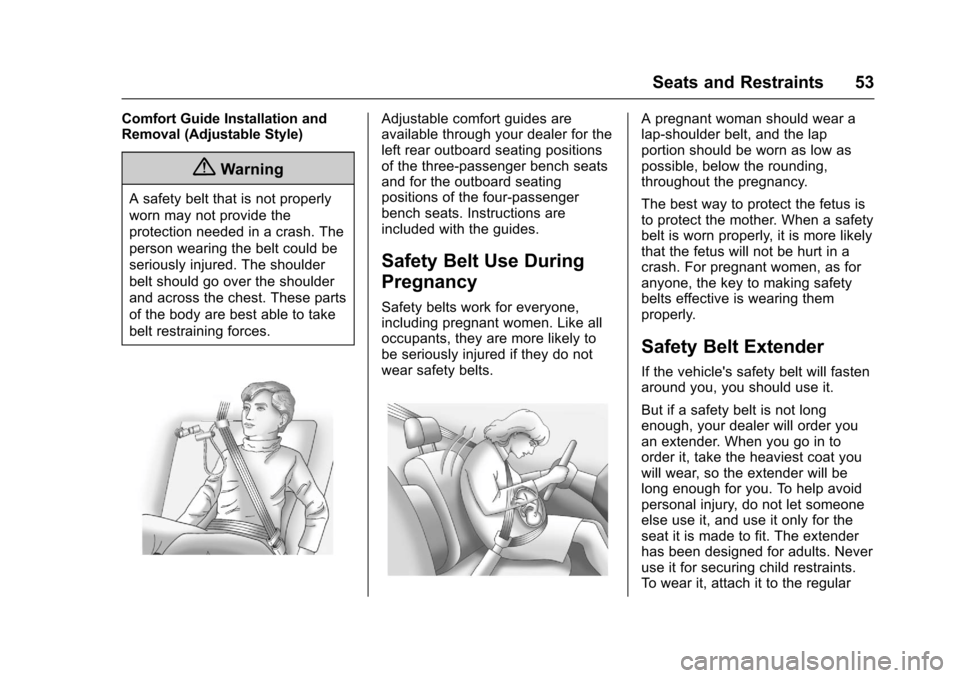
Chevrolet Express Owner Manual (GMNA-Localizing-U.S./Canada/Mexico-9967827) - 2017 - crc - 5/2/16
Seats and Restraints 53
Comfort Guide Installation andRemoval (Adjustable Style)
{Warning
Asafetybeltthatisnotproperly
worn may not provide the
protection needed in a crash. The
person wearing the belt could be
seriously injured. The shoulder
belt should go over the shoulder
and across the chest. These parts
of the body are best able to take
belt restraining forces.
Adjustable comfort guides areavailable through your dealer for theleft rear outboard seating positionsof the three-passenger bench seatsand for the outboard seatingpositions of the four-passengerbench seats. Instructions areincluded with the guides.
Safety Belt Use During
Pregnancy
Safety belts work for everyone,including pregnant women. Like alloccupants, they are more likely tobe seriously injured if they do notwear safety belts.
Apregnantwomanshouldwearalap-shoulder belt, and the lapportion should be worn as low aspossible, below the rounding,throughout the pregnancy.
The best way to protect the fetus isto protect the mother. When a safetybelt is worn properly, it is more likelythat the fetus will not be hurt in acrash. For pregnant women, as foranyone, the key to making safetybelts effective is wearing themproperly.
Safety Belt Extender
If the vehicle's safety belt will fastenaround you, you should use it.
But if a safety belt is not longenough, your dealer will order youan extender. When you go in toorder it, take the heaviest coat youwill wear, so the extender will belong enough for you. To help avoidpersonal injury, do not let someoneelse use it, and use it only for theseat it is made to fit. The extenderhas been designed for adults. Neveruse it for securing child restraints.To w e a r i t , a t t a c h i t t o t h e r e g u l a r
Page 58 of 346
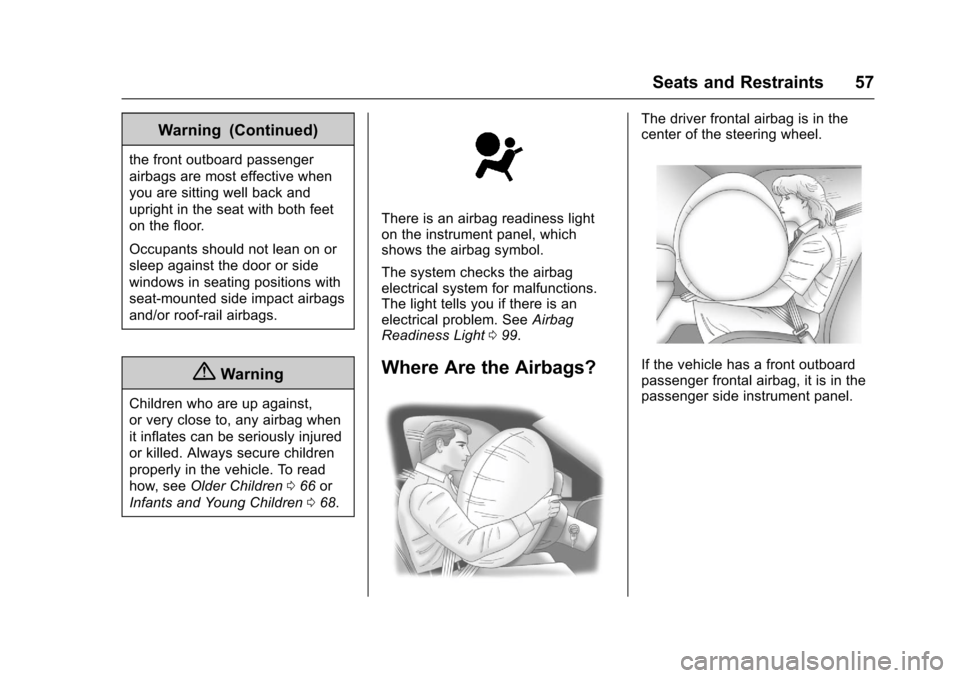
Chevrolet Express Owner Manual (GMNA-Localizing-U.S./Canada/Mexico-9967827) - 2017 - crc - 5/2/16
Seats and Restraints 57
Warning (Continued)
the front outboard passenger
airbags are most effective when
you are sitting well back and
upright in the seat with both feet
on the floor.
Occupants should not lean on or
sleep against the door or side
windows in seating positions with
seat-mounted side impact airbags
and/or roof-rail airbags.
{Warning
Children who are up against,
or very close to, any airbag when
it inflates can be seriously injured
or killed. Always secure children
properly in the vehicle. To read
how, seeOlder Children066or
Infants and Young Children068.
There is an airbag readiness lighton the instrument panel, whichshows the airbag symbol.
The system checks the airbagelectrical system for malfunctions.The light tells you if there is anelectrical problem. SeeAirbagReadiness Light099.
Where Are the Airbags?
The driver frontal airbag is in thecenter of the steering wheel.
If the vehicle has a front outboardpassenger frontal airbag, it is in thepassenger side instrument panel.
Page 63 of 346
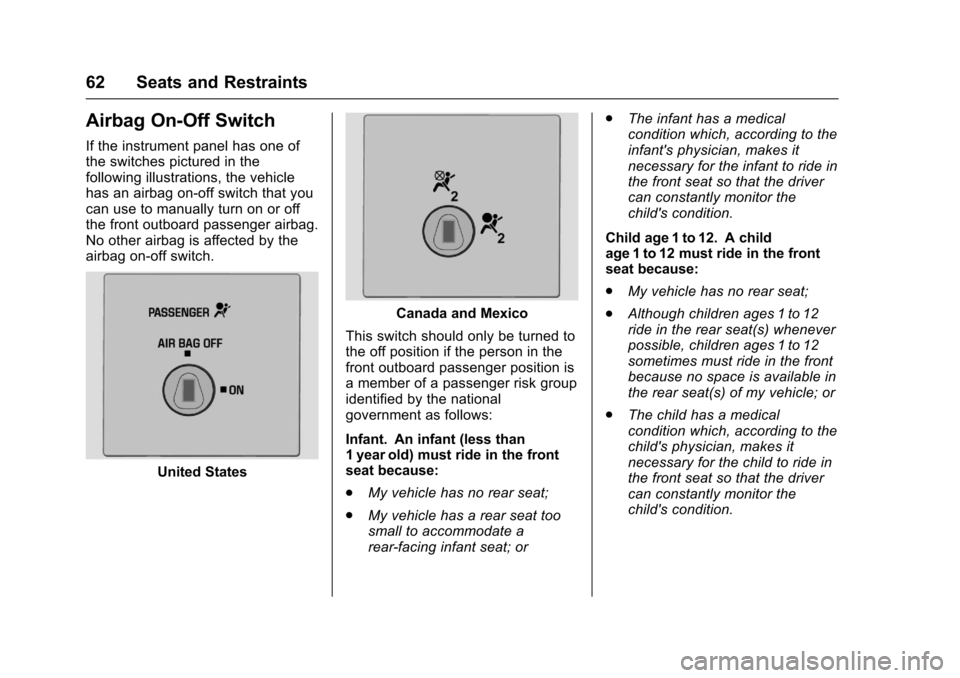
Chevrolet Express Owner Manual (GMNA-Localizing-U.S./Canada/Mexico-9967827) - 2017 - crc - 5/2/16
62 Seats and Restraints
Airbag On-Off Switch
If the instrument panel has one ofthe switches pictured in thefollowing illustrations, the vehiclehas an airbag on-off switch that youcan use to manually turn on or offthe front outboard passenger airbag.No other airbag is affected by theairbag on-off switch.
United States
Canada and Mexico
This switch should only be turned tothe off position if the person in thefront outboard passenger position isamemberofapassengerriskgroupidentified by the nationalgovernment as follows:
Infant. An infant (less than1 year old) must ride in the frontseat because:
.My vehicle has no rear seat;
.My vehicle has a rear seat toosmall to accommodate arear-facing infant seat; or
.The infant has a medicalcondition which, according to theinfant's physician, makes itnecessary for the infant to ride inthe front seat so that the drivercan constantly monitor thechild's condition.
Child age 1 to 12. A childage 1 to 12 must ride in the frontseat because:
.My vehicle has no rear seat;
.Although children ages 1 to 12ride in the rear seat(s) wheneverpossible, children ages 1 to 12sometimes must ride in the frontbecause no space is available inthe rear seat(s) of my vehicle; or
.The child has a medicalcondition which, according to thechild's physician, makes itnecessary for the child to ride inthe front seat so that the drivercan constantly monitor thechild's condition.
Page 67 of 346
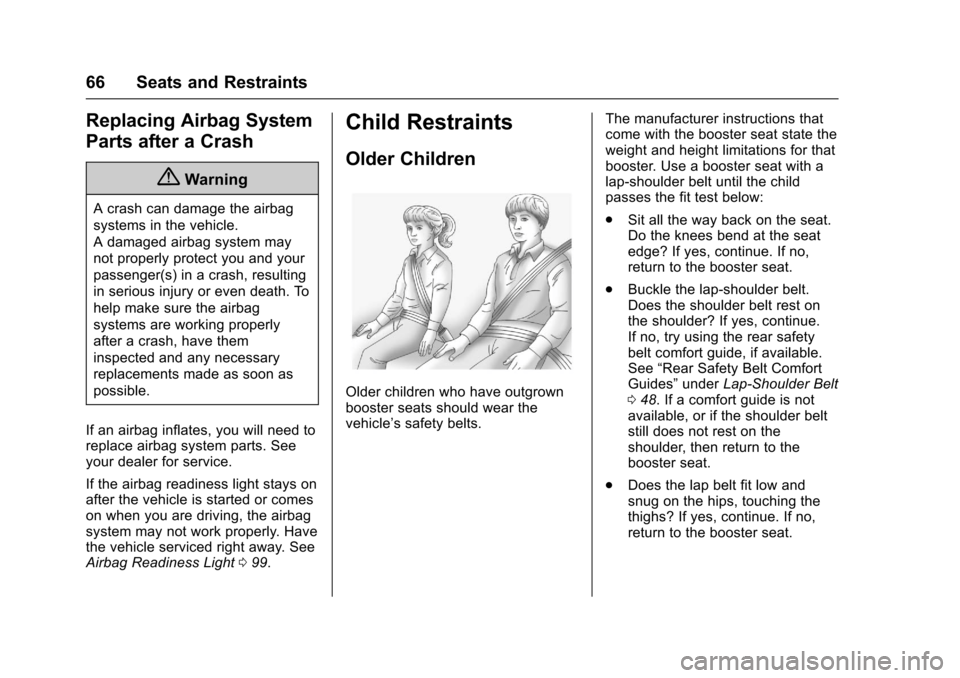
Chevrolet Express Owner Manual (GMNA-Localizing-U.S./Canada/Mexico-9967827) - 2017 - crc - 5/2/16
66 Seats and Restraints
Replacing Airbag System
Parts after a Crash
{Warning
Acrashcandamagetheairbag
systems in the vehicle.
Adamagedairbagsystemmay
not properly protect you and your
passenger(s) in a crash, resulting
in serious injury or even death. To
help make sure the airbag
systems are working properly
after a crash, have them
inspected and any necessary
replacements made as soon as
possible.
If an airbag inflates, you will need toreplace airbag system parts. Seeyour dealer for service.
If the airbag readiness light stays onafter the vehicle is started or comeson when you are driving, the airbagsystem may not work properly. Havethe vehicle serviced right away. SeeAirbag Readiness Light099.
Child Restraints
Older Children
Older children who have outgrownbooster seats should wear thevehicle’ssafetybelts.
The manufacturer instructions thatcome with the booster seat state theweight and height limitations for thatbooster. Use a booster seat with alap-shoulder belt until the childpasses the fit test below:
.Sit all the way back on the seat.Do the knees bend at the seatedge? If yes, continue. If no,return to the booster seat.
.Buckle the lap-shoulder belt.Does the shoulder belt rest onthe shoulder? If yes, continue.If no, try using the rear safetybelt comfort guide, if available.See“Rear Safety Belt ComfortGuides”underLap-Shoulder Belt048.Ifacomfortguideisnotavailable, or if the shoulder beltstill does not rest on theshoulder, then return to thebooster seat.
.Does the lap belt fit low andsnug on the hips, touching thethighs? If yes, continue. If no,return to the booster seat.